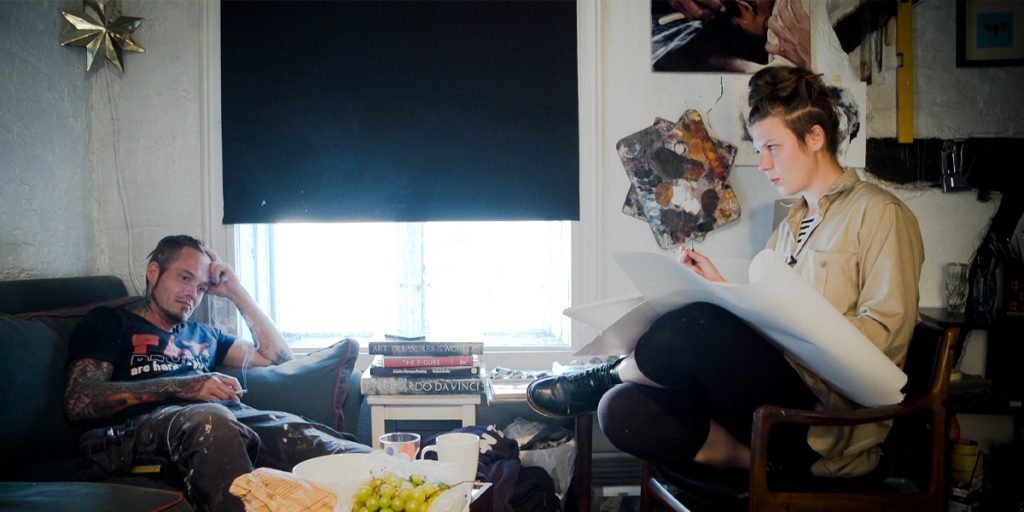Benjamin Rees’ new documentary The Painter and the Thief tells a story of art and the unlikely relationships it can lead to.
It’s amazing to see what sparks creative inspiration for people. In the case of Barbora Kysilkova, one of the subjects of Benjamin Rees’ new documentary The Painter and the Thief, that inspiration often comes from the darker moments in her life. One of those moments came in 2015, when two of her oil paintings, valued at €20,000, were stolen from the Galleri Nobel in Oslo, Norway. The trial that followed led to her meeting Karl-Bertil Nordland, one of the two men charged with stealing the paintings, and prompted the question that Kysilkova asked to kickstart the story of this film: “I wonder if I could paint you?”
The Painter and the Thief is set to make its debut in the United Kingdom this week at the London Film Festival. The documentary premiered at the Sundance Film Festival in January, where it won the World Cinema Documentary Special Jury Award for Creative Storytelling. It focuses on Kysilkova and Nordland and the relationship that they form after that first meeting — and the way that, ultimately, they both need one another.
The first time the two subjects of the documentary get together for Kysilkova to paint Nordland, he appears to be just ready to get things over with. He’s sitting on the couch in her studio: he’s not necessarily looking disinterested, but there certainly is an awkwardness to the situation, and how the two have gotten, to where they are in that moment. But the big breakthrough comes when she eventually has the painting to a point where she can show it to him, unveiling this amazing photo-realistic portrait of him, that gives us the first of many raw emotional moments in this film.
He’s taken aback by what he sees — a look of amazement and wonder in his eyes, in a way that shows that this is a truly emotional moment for him. Through her art, he sees that Kysilkova sees him as more than just one of the guys who stole her artwork. She sees him as a person, she isn’t judging him for the things he’s done in his past but for the person he can be. You can tell it’s been a while since he’s had someone (especially a person who is a relative stranger) look at him in that way, and the way that Rees keeps his camera on him as he stares at it in silent amazement and slowly breaks down is a great, impactful choice that locks you into the film early on.
“Nobody has ever seen me vulnerable like you,” Nordland tells Kysilkova during the documentary. “True, pure friendship.” That’s a quote that sums up what we get the rest of the way quite nicely. We see the ups and downs Nordland and Kysilkova go through, both in their relationships with one another and in their lives in general, and the way they ultimately turn to each other to help them get through those difficult moments. He becomes her muse during this time, coming in to model for her frequently, as they keep building that relationship and we see a friendship grow — even though there are moments where they are both trying to figure out how much they can trust the other.
The decision to spend time showing the story from the points of view of both characters, so we can get into both of their heads throughout, is effective because it shows us that skepticism coming from both sides, and gives us a glimpse into the issues they have that maybe don’t come out as much when they’re together and working on Kysilkova’s art. Seeing some of the same moments we saw earlier in the film with Kysilkova’s narration, but with Nordland talking over it as he tells us, “She sees me very well, but she forgets that I can see her too,” gives it a clever structure, in the way the story of their relationship is told.
The Painter and the Thief shows its main characters in the moments where they’re having some relationship issues. We see when Nordland falls back into his problems with drugs, and things that ultimately get him into trouble. We watch as Kysilkova struggles to make ends meet and breaks down when she isn’t able to get her work into galleries and in front of the people she needs in order to make money. In the moments they’re apart, we see them reflect on each other and understand the trauma they have gone through, and you can see the way that, as they form that knowledge of one another, they lean on each other in a fairly co-dependent relationship.
The way that Rees fine shows us these two characters, as more than just a caricature of who we might see them as on the outside, makes The Painter and the Thief really work. He easily could have shown Nordland in a way that portrayed him as only a thief and a junkie, or Kysilkova as the bright artist looking for the person behind that image of the thief who stole her art. Instead, what we get is a full portrait, the good and the bad, of who these people are and the things that they go through that make them the people they ultimately become. It’s a really interesting telling of this story, that shows the way people can find inspiration in odd places, with an ending that leaves behind some intriguing questions about the type of relationship they have.
The Painter and the Thief will be screened digitally, at the BFI London Film Festival, from Thursday 8 October 2020. The film, which is currently streaming on Hulu in the US, will be available in UK cinemas and on demand from 30 October.

